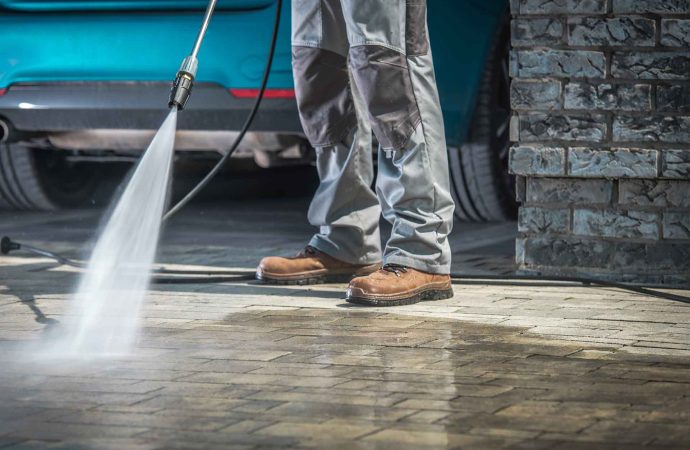Canada is home to beautiful winters, with nice, cold weather paired with calming flurries of snow. However, that same exact scenery can turn into a disaster, with weather conditions going into negative double digits and snow piling up to 10 to 20 centimeters. With that being said, these harsh weather conditions can be damaging to
Canada is home to beautiful winters, with nice, cold weather paired with calming flurries of snow. However, that same exact scenery can turn into a disaster, with weather conditions going into negative double digits and snow piling up to 10 to 20 centimeters. With that being said, these harsh weather conditions can be damaging to your driveway, with all of the snow and freezing temperatures mentioned above taking their toll on its surface. You may experience various problems and hazards, like chipping of the driveway or it becoming too slippery to even walk on. However, by following the do’s and don’ts down below, you, as a homeowner, can protect your driveway and ensure that they stay in good condition throughout the winter season.
Do’s
Clear the Driveway of Snow and Ice ASAP
One of the most crucial actions a homeowner can do to safeguard their house during the winter is to immediately clear the driveway of snow and ice. If left unattended, snow and ice may seriously harm a driveway and make it slippery and hazardous for both automobiles and pedestrians. Homeowners may aid in preventing this harm and guarantee that their driveways stay in good shape throughout the winter by clearing snow and ice as soon as feasible. A driveway should be cleared of snow and ice as soon as possible for several reasons, one of which is that doing so can assist to stop ice from forming. When snow and ice are left on a driveway, they may freeze and harden, making it much more challenging to remove them later. Additionally, compacted snow and ice may cause water to collect on the driveway’s surface. This may result in the production of ice, making the surface slippery and hazardous. Homeowners may assist to avoid these problems and make sure that their driveways are safe and functional by clearing snow and ice as soon as possible. Another significant advantage of removing snow and ice from a driveway as soon as possible is that it can aid in preventing damage to the driveway’s surface. A driveway may become damaged over time from snow and ice, especially if they are not cleared right away. For instance, if a vehicle travels over compacted snow and ice, it may cause the snow and ice to become even more compressed and more challenging to remove. Compacted snow and ice can also harm the driveway’s surface by creating potholes and other defects. A driveway should be cleared of snow and ice as soon as possible to avoid damaging the cars that utilize it. A vehicle’s wheels, tires, and other components may be harmed as it travels through compacted snow and ice. Compacted snow and ice can also make cars slide, which is dangerous and raises the possibility of accidents. Homeowners may assist to avoid these problems and make sure that cars can drive on the driveway safely by immediately clearing the driveway of snow and ice.
Use De-icing Products
The driveway of a home may be effectively protected during the winter by using de-icing products on it. By melting snow and ice, these items make it simpler to clear the driveway and stop the growth of ice. Additionally, they can make the driveway safer for automobiles and people walking on it by preventing damage to the driveway’s surface. To prevent any potential harm to the driveway, it is crucial to apply de-icing solutions properly. The advantage of applying deicing solutions to a driveway is that they can stop ice from forming. Ice can be quite hazardous on a driveway since it makes the ground slippery and raises the possibility of accidents. If snow and ice are allowed to accumulate on a driveway, they may freeze, get compacted, and eventually form ice. Homeowners may avoid the accumulation of ice and guarantee that their driveways are safe and usable by utilizing de-icing solutions. To prevent any potential harm to the driveway, it is crucial to apply de-icing solutions properly. The surface of the driveway may be harmed by the excessive use of de-icing solutions, which can also be bad for the environment. Additionally, the driveway may be harmed if the incorrect de-icing product is used. For instance, applying a product with an excessive amount of chloride might damage roadways made of concrete and asphalt. As a result, it’s crucial to apply de-icing goods as directed and to pick the appropriate product for the driveway’s kind.
Seal the Driveway
The opportunity to easily clean the driveway is another advantage of driveway sealing. Snow and ice may be repelled off a driveway when it has been coated, making snow removal easier. A sealed driveway can also make it simpler to remove road salt since it prevents the salt from penetrating the driveway’s surface. This can lessen the time and effort needed to clear the driveway and improve the safety of the driveway for both vehicles and pedestrians. The overall look of a home’s driveway can be enhanced by sealing it. A smooth, glossy surface on a paved driveway can serve to improve the property’s appearance as a whole. The colour of the driveway may also be protected, and a sealed driveway can keep it looking new for longer. This might be crucial for homeowners who wish to keep their property’s curb appeal throughout the winter. To guarantee that the driveway is preserved during the winter, it is crucial to use the right kind of sealer and to apply it appropriately. A sealer that is inappropriate for the driveway’s type might harm the surface and offer insufficient protection. Furthermore, if the sealant is not placed properly, it could not offer the necessary amount of protection and might potentially harm the driveway’s surface. It is crucial to select the appropriate sealer for the driveway type and apply it according to the manufacturer’s directions.
Regular Inspection
One of the main advantages of routinely evaluating a driveway is that it enables homeowners to spot any possible difficulties and take care of them before they worsen. If a homeowner, for instance, detects a hole in the driveway, they may fix it before it becomes worse and costs more to fix. Additionally, if a homeowner observes that the driveway’s surface is getting uneven, they may fix the problem before it poses a risk to their safety. Homeowners may avoid expensive repairs and guarantee that their driveways stay in good shape all winter long by spotting and fixing these problems early on. Another advantage of routinely evaluating a home’s driveway is that it may assist to guarantee that it is secure for usage by cars and pedestrians all winter long. For instance, if a homeowner observes that the driveway’s surface is becoming slick, they can take action before it poses a risk to their safety. A homeowner may also take action to remove the ice from the driveway and make it safer to use if they see that it is starting to get icy. Homeowners may contribute to the reduction of wintertime accidents and injuries by making sure the driveway is safe to use. Regular driveway inspections can aid in spotting any drainage problems with a house. The driveway may turn ice and be hazardous in the winter if water is not adequately drained. In addition, water that is not adequately drained over time may harm the driveway. Homeowners may contribute to ensuring that their driveways are safe and in excellent shape during the winter by detecting and resolving any drainage concerns. The influence of the surrounding landscape on the driveway should also be considered. For instance, if there are any trees or plants that hang over the driveway, they may endanger the surface if their branches become clogged with snow or ice. Additionally, if the landscaping is not kept up, the driveway may freeze and become hazardous in the winter.
Don’ts
Don’t Park on the Driveway When it is Covered in Snow or Ice
During the winter, parking on a driveway that is coated in snow or ice might harm the driveway’s structural integrity. Parking a car on a snow- or ice-covered driveway causes the snow and ice to compress, making it much more challenging to remove later. The weight of the car can also cause snow and ice to melt and then refreeze, leaving a coating of ice that is very hard to remove without harming the driveway’s surface. Additionally, the driveway surface may become uneven as a result of the car’s continual movement over the compacted snow and ice, and uneven surfaces may harm the suspension or wheels of the vehicle. Furthermore, the driveway surface may become slick and slippery due to the frequent movement of the car over the compacted snow and ice, increasing the likelihood of accidents and injuries. Moreover, parking a car on a driveway coated in snow and ice can cause the snow and ice to melt and then refreeze, which, as mentioned earlier, would create a coating of ice that is nearly hard to remove without harming the driveway’s surface. Potholes, cracks, and other sorts of damage that can be expensive and time-consuming to fix may result from this.
Don’t Use Metal Tools to Remove Snow or Ice
It is not advised to safeguard a driveway during the winter by clearing snow or ice with metal instruments since doing so can seriously harm the driveway’s surface. The fact that metal tools might scratch and damage the driveway’s surface is one of the key justifications for why they shouldn’t be used. Shovels and other equipment’s metal edges may leave unattractive markings and scratches on the driveway’s surface when they scrape against it. These scuffs can degrade the driveway’s surface over time, leaving it more prone to cracking and other types of damage. Metal tools should not be used on the driveway’s surface since they might be excessively abrasive and harsh for it. These tools’ metal edges have the potential to damage and break the driveway’s surface by digging into them. When snow and ice accumulate in these crevices, the driveway’s surface can become even more dangerously hazardous. To clear snow and ice from a driveway, it is advised to use plastic or rubber tools since they are gentler to the surface and less prone to harm it. Shovels and brooms made of plastic or rubber are also less harmful, so they won’t scrape or ruin the driveway’s surface.
Don’t Ignore the Weather Forecast
For homeowners trying to preserve their driveways throughout the winter, ignoring the weather prediction can be a costly error. Listening to the weather forecast allows homeowners to take the necessary precautions to safeguard their drives before the storms arrive. Weather forecasts are an essential tool for determining when snow and ice storms are likely to occur. Ignoring the weather prediction can catch homeowners off guard when a snow or ice storm arrives, which is one of the primary reasons why doing so is bad for preserving a home’s driveway during the winter. Homeowners may not have the chance to clear their driveways of snow and ice before the storm comes if they are unaware that one is approaching. This can make it much more challenging to remove the snow afterward. In addition, if a storm is expected, homeowners can use de-icing solutions prior to the first snowfall to help prevent snow and ice from bonding to the driveway’s surface. Additionally, disregarding weather prediction might prevent residents from knowing crucial details about the intensity and length of a storm. In the event of a large snowstorm, for instance, homeowners may need to take extra precautions to safeguard their driveways, such as utilizing a snow blower or engaging a specialized snow removal service. On the other hand, homeowners might be able to get away with merely shovelling their driveways by hand if a prediction calls for a little snowfall.
The driveway of your home is just as important as any other part of your home. The winter weather may pose a danger to your driveway, so in order to protect it, there are several do’s and don’ts that you must follow. Some of the do’s that you should complete this winter season include clearing the driveway of snow and ice as soon as possible, using de-icing products, sealing the driveway, and completing a regular inspection on your driveway. Some of the don’ts that you must follow include not parking on the driveway when it is covered in snow or ice, not using metal tools to remove snow or ice, and not listening to the weather forecast. If you do find that your driveway has experienced some damage, it is important that you talk to a concrete contractor as soon as possible.

















